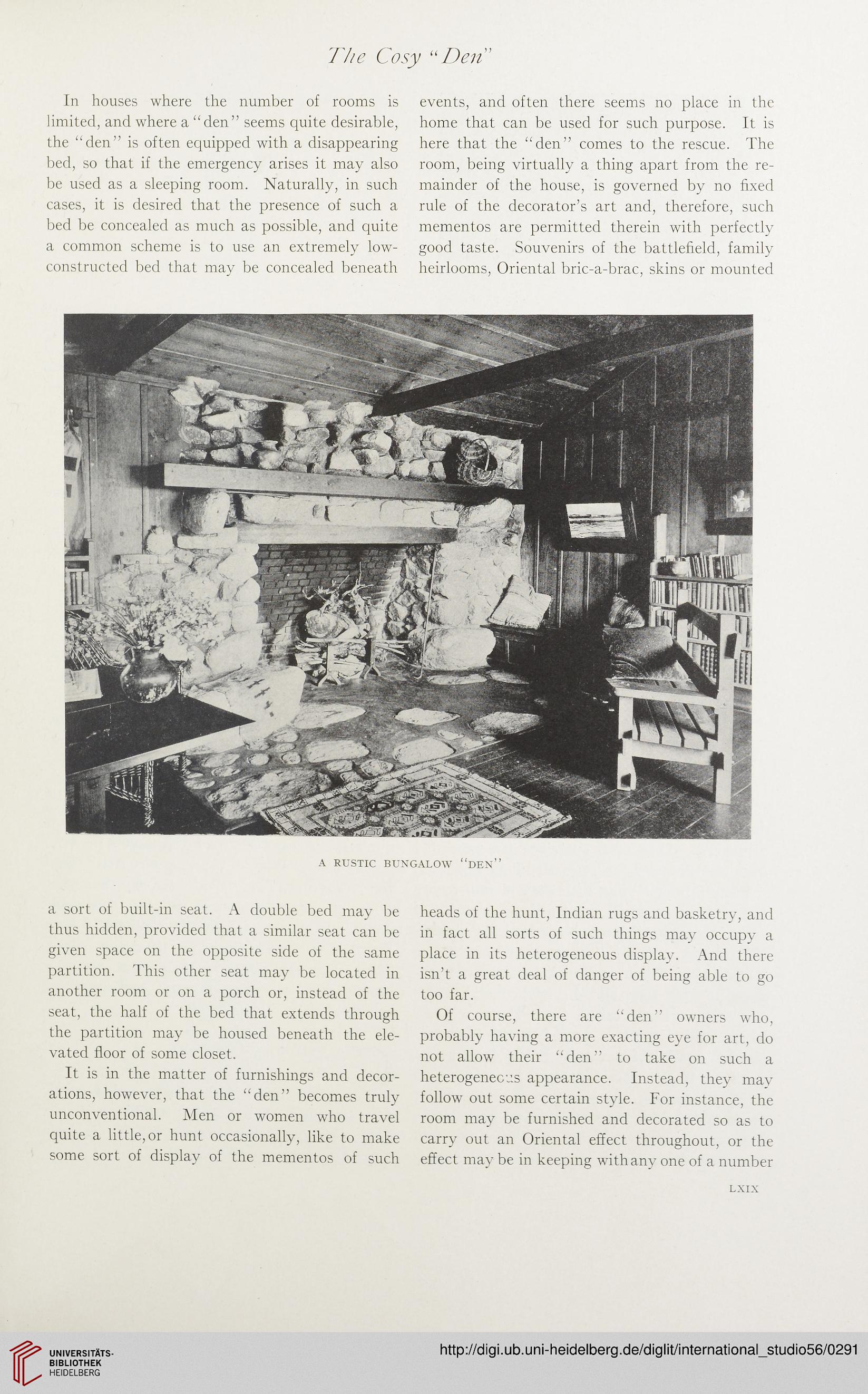The Cosy “Den
In houses where the number of rooms is
limited, and where a “den” seems quite desirable,
the “den” is often equipped with a disappearing
bed, so that if the emergency arises it may also
be used as a sleeping room. Naturally, in such
cases, it is desired that the presence of such a
bed be concealed as much as possible, and quite
a common scheme is to use an extremely low-
constructed bed that may be concealed beneath
events, and often there seems no place in the
home that can be used for such purpose. It is
here that the “den” comes to the rescue. The
room, being virtually a thing apart from the re-
mainder of the house, is governed by no fixed
rule of the decorator’s art and, therefore, such
mementos are permitted therein with perfectly
good taste. Souvenirs of the battlefield, family
heirlooms, Oriental bric-a-brac, skins or mounted
A RUSTIC BUNGALOW “DEN”
a sort of built-in seat. A double bed may be
thus hidden, provided that a similar seat can be
given space on the opposite side of the same
partition. This other seat may be located in
another room or on a porch or, instead of the
seat, the half of the bed that extends through
the partition may be housed beneath the ele-
vated floor of some closet.
It is in the matter of furnishings and decor-
ations, however, that the “den” becomes truly
unconventional. Men or women who travel
quite a little, or hunt occasionally, like to make
some sort of display of the mementos of such
heads of the hunt, Indian rugs and basketry, and
in fact all sorts of such things may occupy a
place in its heterogeneous display. And there
isn’t a great deal of danger of being able to go
too far.
Of course, there are “den” owners who,
probably having a more exacting eye for art, do
not allow their “den” to take on such a
heterogeneous appearance. Instead, they may
follow out some certain style. For instance, the
room may be furnished and decorated so as to
carry out an Oriental effect throughout, or the
effect may be in keeping with any one of a number
LXIX
In houses where the number of rooms is
limited, and where a “den” seems quite desirable,
the “den” is often equipped with a disappearing
bed, so that if the emergency arises it may also
be used as a sleeping room. Naturally, in such
cases, it is desired that the presence of such a
bed be concealed as much as possible, and quite
a common scheme is to use an extremely low-
constructed bed that may be concealed beneath
events, and often there seems no place in the
home that can be used for such purpose. It is
here that the “den” comes to the rescue. The
room, being virtually a thing apart from the re-
mainder of the house, is governed by no fixed
rule of the decorator’s art and, therefore, such
mementos are permitted therein with perfectly
good taste. Souvenirs of the battlefield, family
heirlooms, Oriental bric-a-brac, skins or mounted
A RUSTIC BUNGALOW “DEN”
a sort of built-in seat. A double bed may be
thus hidden, provided that a similar seat can be
given space on the opposite side of the same
partition. This other seat may be located in
another room or on a porch or, instead of the
seat, the half of the bed that extends through
the partition may be housed beneath the ele-
vated floor of some closet.
It is in the matter of furnishings and decor-
ations, however, that the “den” becomes truly
unconventional. Men or women who travel
quite a little, or hunt occasionally, like to make
some sort of display of the mementos of such
heads of the hunt, Indian rugs and basketry, and
in fact all sorts of such things may occupy a
place in its heterogeneous display. And there
isn’t a great deal of danger of being able to go
too far.
Of course, there are “den” owners who,
probably having a more exacting eye for art, do
not allow their “den” to take on such a
heterogeneous appearance. Instead, they may
follow out some certain style. For instance, the
room may be furnished and decorated so as to
carry out an Oriental effect throughout, or the
effect may be in keeping with any one of a number
LXIX




